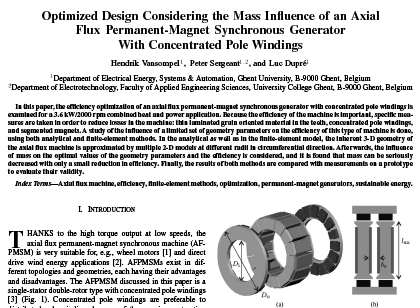In this paper. the efficiency optimization of an axial flux permanent-magnet synchronous generator with concentrated pole windings is examined for a 3.6 kW 2000 rpm combined heat and power application. Because the efficiency of the machine is important. specific measures are taken in order to reduce losses in the machine: thin laminated grain oriented material in the teeth. concentrated pole windings. and segmented magnets. A study of the influence of a limited set of geometry parameters on the efficiency of this type of machine is done. using both analytical and finite-element methods. In the analytical as well as in the finite-element model. the inherent 3-D geometry of the axial flux machine is approximated by multiple 2-D models at different radii in circumferential direction. Afterwards. the influence of mass on the optimal values of the geometry parameters and the efficiency is considered. and it is found that mass can be seriously decreased with only a small reduction in efficiency. Finally. the results of both methods are compared with measurements on a prototype to evaluate their validity.

 Iran Energy News Oil, Gas, Petrochemical and Energy Field Specialized Channel
Iran Energy News Oil, Gas, Petrochemical and Energy Field Specialized Channel



